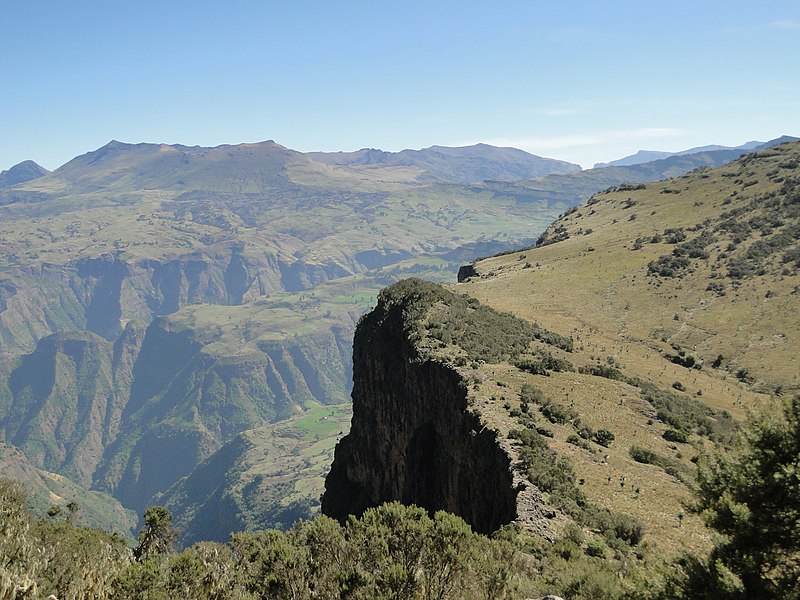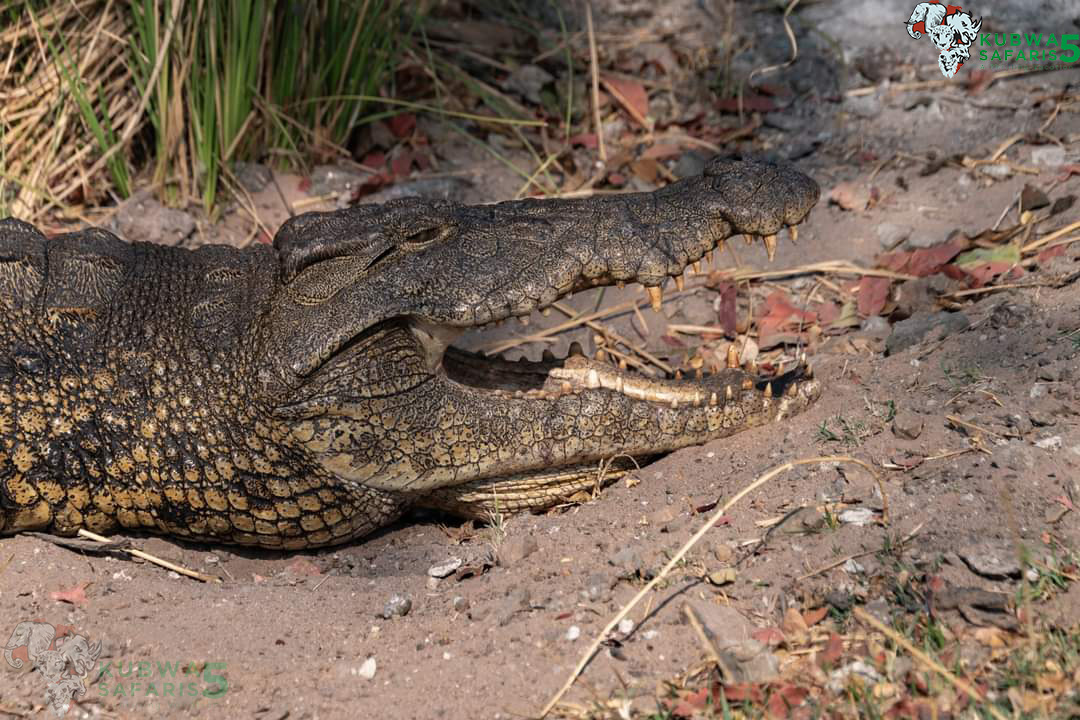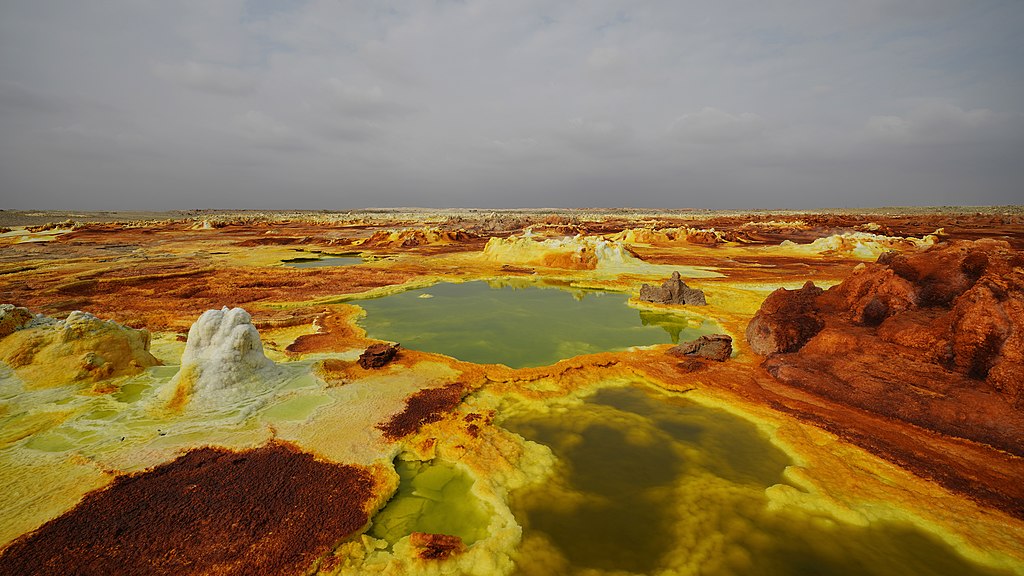Table of Contents
The Top 10 Best Attractions In Ethiopia
The Top 10 Best Attractions In Ethiopia, a country rich in cultural heritage and natural wonders, it is poised to capture the hearts of global travelers with its diverse attractions.
Tourism in Ethiopia has become a focal point of the government’s initiatives embedded in the Poverty Reduction Strategy Paper (PRSP) aimed at fostering economic development and combating poverty.
Despite a challenging history marked by a decline in the 1970s and 1980s, the country has witnessed a resurgence in the 1990s showcasing an array of enchanting destinations.
From the ancient cities of Axum, Lalibela, and Gondar to the Harar Jugol walled city and the breathtaking Semien Mountains National Park, Ethiopia offers a tapestry of historic sites and national parks.
The nation boasts nine UNESCO World Heritage Sites, including the rock-hewn churches at Lalibela, the ruins of Aksum, and the Simien Mountains National Park reflecting Ethiopia’s cultural and natural treasures.
Noteworthy is the country’s commitment to ecotourism, a growing trend that holds significant potential for further development. As travel retail sales continue to surge fueled by the increasing interest in ecotourism packages, Ethiopia emerges as a promising destination, blending history, nature, and adventure to create a unique and unforgettable experience for visitors.
The following are the top 10 best attraction in Ethiopia;
1. Simien Mountain National Park
Simien Mountains National Park is the Ethiopia’s largest national park and situated in the North Gondar Zone of the Amhara Region encompassing the elevated expanse of the Simien Mountains which includes Ras Dashan, the country’s highest peak.
This biodiverse sanctuary shelters endangered species such as the Ethiopian wolf and the walia ibex, a unique wild goat species. The park also hosts the gelada baboon, the elusive caracal cat, and over 50 bird species, including the majestic bearded vulture with its impressive 3-meter wingspan.
An unpaved road traverses the park from Debarq, the administrative headquarters eastward through villages to the Buahit Pass at 4,430 meters before turning southward to conclude at Mekane Berhan just beyond the park boundary.

2. Addis Ababa
Addis Ababa is a vibrant capital and largest city of Ethiopia, it boasts a rich history dating back to the late 19th century when Emperor Menelik II founded it in 1886.
Initially it was established as a resort town with abundant mineral springs and later the city quickly evolved into a cultural, artistic, and administrative hub.
Menelik II’s imperial palace was established in 1887 marking the city’s significance. Over the years, Addis Ababa experienced economic growth, urban development, and modernization especially during the Italian occupation.
Today, it stands as a federally-chartered city and is often referred to as “the political capital of Africa.” With its strategic location near the East African Rift.
Addis Ababa is not only a melting pot of diverse Ethiopian cultures but also serves as the headquarters for major international organizations including the African Union and the United Nations Economic Commission for Africa.
The city is characterized by a high human development index, a vibrant culture, a thriving arts scene, and active civic and political engagement, making it a symbol of Ethiopia’s rapid economic growth and dynamism.

3. Rock-Hewn Churches of Lalibela
The eleven are monolithic churches located in the Western Ethiopian Highlands near the town of Lalibela.
The eleven Rock-hewn Churches stand as a remarkable testament to the late-12th and early-13th century vision of King Gebre MRock-hewn Churches of Lalibelaeskel Lalibela of the Zagwe dynasty.
It was commissioned with the ambitious goal of recreating the sacred city of Jerusalem within his kingdom, these monolithic churches are an awe-inspiring feat of architecture. Carved from solid rock, the churches have served as a sacred site for Ethiopian Orthodox Christian worship since their completion, drawing pilgrims to experience their religious significance.
The 24-year construction effort reflects the dedication and craftsmanship that went into crafting these enduring symbols of faith and architectural marvels.

4. Omo National Park and River
Omo National Park was established in 1980 in Ethiopia which is a remote and expansive natural reserve situated in the Southern part of Ethiopia.
it encompasses approximately 4,068 square kilometers, the park lies about 870 kilometers southwest of Addis Ababa with Mago National Park and Tama Wildlife Reserve located on the opposite bank of the Omo River.
Despite the recent addition of an airstrip near the park headquarters on the Mui River accessibility remains a challenge earning Omo National Park the designation of “Ethiopia’s most remote park” by the Lonely Planet guide.
The park’s geographical features include the Omo River to the east, Maji Mountains, Sharum and Sai plains to the north and west and Illibai plains and Dirga Hills to the south.
With dimensions stretching from the Neruze River in the south to the Sharum plain in the north and up to 60 km wide around the Park Headquarters. Omo National Park boasts a diverse landscapes including hot springs and rivers that ultimately drain into the Omo.
The park’s elevation varies, with the southern region near the Neruze River dropping to 450 m, while the highest peak in the Maji Mountains reaches 1,541 m above sea level, contributing to the park’s rich and varied topography.

5. National Museum of Ethiopia
The National Museum of Ethiopia is situated in Addis Ababa near the Addis Ababa University’s graduate school and stands as a testament to the country’s cultural and historical heritage.
It originated in 1936 with an exhibition on ceremonial costumes from the Solomonic dynasty, the museum evolved from the Institute of Archaeology, founded in 1958 by French archaeologists.
Under the Ethiopian Cultural Heritage Administration since 1976, it operated with three departments – conservation, documentation, and exhibition/research. The museum’s four main sections offer a comprehensive journey through Ethiopia’s past and present.
The basement showcases archaeological and paleoanthropological wonders including the famed “Lucy” and the recent addition of Selam. The first floor presents ancient and medieval artifacts, regalia, and memorabilia, while the second floor displays a chronological spectrum of artwork from traditional to contemporary pieces.
Notable works like Afewerk Tekle’s “African Heritage” grace this floor, alongside secular arts and crafts. The third floor provides an ethnographic panorama, highlighting the diverse cultural richness of Ethiopia and its people.

6. Bahir Dar
Bahir Dar translated as “sea shore” in Amharic stands as a prominent town in the Amhara Region of Ethiopia.
It is a renowned as a leading tourist destination in the country, Bahir Dar boasts a multitude of attractions centered around the nearby Lake Tana and the Blue Nile River.
The city’s charm is characterized by broad avenues adorned with palm trees and a vibrant array of colorful flowers. In recognition of its efforts in managing the challenges of rapid urbanization, Bahir Dar was honored with the UNESCO Cities for Peace Prize in 2002.
As a significant hub in the Amhara Region, the town encapsulates the rich cultural and natural heritage that draws visitors from far and wide.

7. Lake Tana
Lake Tana which is also known as “T’ana ḥāyik’i” in Amharic stands as Ethiopia’s largest lake and serves as the source of the Blue Nile. It is nestled in the north-western Ethiopian Highlands within the Amhara Region, this expansive waterbody spans approximately 84 kilometers in length and 66 kilometers in width boasting a maximum depth of 15 meters and an elevation of 1,788 meters.
It is Fed by the Gilgel Abay, Reb and Gumara rivers, Lake Tana’s surface area fluctuates between 3,000 to 3,500 square kilometers, influenced by seasonal variations and rainfall.
It is regulated by a control weir, the lake discharges into the Blue Nile overseeing the flow to the renowned Blue Nile Falls (Tis Abbai) and a hydro-power station.
It is recognized for its natural and cultural significance, the Lake Tana region earned UNESCO Biosphere Reserve status in 2015, affirming its importance on both national and international scales.

Beginning of the Blue Nile river by its outlet from Lake Tana
8. Danakil Depression
The Danakil Depression is situated in the northern part of the Afar Triangle within Ethiopia and is a geological marvel shaped by the divergence of three tectonic plates in the Horn of Africa.
It is positioned at the triple junction of these plates, the depression boasts a complex geological history influenced by the shifting of Africa and Asia leading to rifting and volcanic activity.
This unique landscape has evolved through a dynamic interplay of erosion, sea inundation, and ground movements.
The geological features include sedimentary rocks like sandstone and limestone, overlain by basalt formed from extensive lava flows.
As a result of these intricate geological processes, the Danakil Depression has earned a reputation as one of Earth’s most extraordinary environments and recognized as the ‘hottest place on the planet,’ it is home to mesmerizing salt lakes, lava lakes, volcanoes, and vibrant acidic springs, creating a truly remarkable and otherworldly setting.
9. Blue Nile Falls
The Blue Nile Falls is also known as Tis Abay in Amharic which stand as a breathtaking natural spectacle in West Gojjam, Amhara Region, Ethiopia along the upper course of the Blue Nile River.
It is positioned about 30 kilometers downstream from Bahir Dar and Lake Tana, these falls reaches a height of 42 meters that comprise four streams that can span from a gentle trickle in the dry season to over 400 meters in the rainy season.
Despite the regulation of Lake Tana and the impact of a hydro-electric station since 2003, the falls retain their ecological significance, isolating Lake Tana’s ecology and contributing to the evolution of its endemic fauna.
Beyond their environmental role, the falls boast historical importance with Ethiopia’s first stone bridge which was commissioned in 1626 by Emperor Susenyos.
The best time to visit blue nile fall is during the rainy season from June to early September. This natural wonder stands as a testament to Ethiopia’s rich heritage and stunning landscapes.

10. Red Terror Martyrs Memorial Museum
Red Terror” Martyrs’ Memorial Museum was established in 2010 in Addis Ababa and serves as a poignant tribute to those who perished during the Red Terror under the Derg government.
The museum features exhibits showcasing torture instruments, skulls, bones, coffins, as well as haunting displays of bloody clothes and photographs documenting the victims’ plight.
During guided tours, visitors gain insights into the historical events leading up to the Red Terror, beginning with Haile Selassie’s 80th birthday celebration.
Guides provide narratives about the harsh actions taken against citizens who opposed the Derg, detailing the treatment of prisoners and their clandestine communication methods.
The museum stands as a solemn reminder of a dark chapter in Ethiopian history, fostering understanding and remembrance.

What Accommodation Options Are Found In Ethiopia
Accommodations play a pivotal role in shaping our travel experiences, offering a diverse range of choices to suit different preferences and budgets. In this essay, we will delve into various types of accommodations, from the luxurious hotels to budget-friendly hostels, and explore how online booking platforms have become the go-to source for finding the perfect stay.
1. Hotels
Hotels stand as the most prevalent and easily accessible form of accommodation, ranging from non-star to 5-star options. The rates depend on the amenities provided, and numerous booking sites, such as Booking, Goibibo, Expedia, TripAdvisor, and Travelocity, offer a plethora of choices.
2. Apartments
Apartments provide expansive living spaces with hotel-like amenities, including a significant advantage – a kitchen for personalized cooking. They are often available at a more budget-friendly rate, making them an excellent option for longer stays. Popular booking platforms like Airbnb, Booking, Goibibo, Expedia, and Travelocity offer a wide array of apartment choices.
3. Hostels
For budget-conscious travelers seeking a communal experience, hostels offer shared rooms and common facilities. The social aspect of hostels, where individuals can connect and explore together, makes them ideal for solo travelers. Booking sites like Booking, Goibibo, TripAdvisor, Hostelworld, and Hotels cater to those looking for affordable hostel options.
4. Guesthouses
Guesthouses, converted parts of residential homes, provide a homely atmosphere at a more economical rate compared to hotels. Owners often offer home-cooked meals and various facilities. Booking, Goibibo, Expedia, TripAdvisor, and MakeMyTrip are reliable sources for finding guesthouse accommodations.
5. Bed and Breakfast (B&B)
Bed and Breakfast establishments offer private rooms and morning meals, typically run by private family owners. With options ranging from low to luxury budgets, B&Bs provide a more personalized alternative to traditional hotel stays. Booking, Expedia, Hotels, Travelocity, and TripAdvisor are well-known platforms for B&B bookings.
6. Holiday Homes
Designed for holiday vacations, holiday homes offer spacious rooms and ample surrounding space, providing more privacy than hotels. They are a cost-effective option for larger groups or families on extended stays. Booking, Goibibo, Expedia, Airbnb, and TripAdvisor are prominent platforms for holiday home bookings.
7. Villas
Villas offer luxurious accommodations with well-maintained furnishings, entertainment options, and often feature multiple rooms on a single property. Ideal for large groups, villas provide privacy and seclusion. Booking, Goibibo, Expedia, Hotels, and Travelocity are reliable sources for villa bookings.
8. Homestay
Homestays allow travelers to share a home with locals, providing a unique opportunity to connect with the community. With facilities like food, internet, and furniture, homestays are a budget-friendly option. Platforms like Booking, Goibibo, Airbnb, Homestay, and Trivago facilitate homestay bookings.
10. Resorts
Resorts, a luxurious form of accommodation, offer self-contained commercial spaces with various amenities such as food, entertainment, spa, sports, and shopping. Resorts are often located away from the hustle and bustle of the city, providing a tranquil escape. TripAdvisor, Booking, Goibibo, MakeMyTrip, and Holidify are popular choices for resort bookings.
How To Get To Ethiopia
To visit Ethiopia, foreigners must possess a valid passport and obtain an Ethiopia visa. The eVisa application process is facilitated online where eligible tourists can complete the application form and receive the approved permit via email.
The key document requirements for the Ethiopia eVisa include a valid passport meeting specific criteria, an image of the passport’s biographical page, a recent color passport-style photo, and a debit or credit card for eVisa fees.
Passport Requirements.
1. Passport must be valid for at least 6 months beyond the date of arrival in Ethiopia.
2. Must have at least 2 black pages.
3. Should be issued by an eligible country.
eVisa Form Information.
Applicants need to complete an online form with personal details, passport information, and travel details. Accuracy in providing information is crucial to avoid delays or denials.
Vaccination Recommendations.
While not all vaccinations are compulsory, travelers are advised to consider vaccinations for diseases such as Hepatitis A and B, Typhoid, Cholera, Yellow Fever, Rabies, Meningitis, Polio, MMR, Tdap, Chickenpox, Shingles, Pneumonia, and Influenza. Certificates of vaccinations may be required, and travelers should consult a medical professional for guidance.
Eligible Countries.
The Ethiopia eVisa is available to passport holders from every country worldwide, requiring a minimum of 6 months validity on the passport. However, citizens of Kenya can enter for up to one year, and Djibouti citizens can enter visa-free for up to three months.
Additionally, residents of certain countries, including Canada, the United States, the United Kingdom, China, Germany, Italy, and Kenya, are eligible for an Ethiopian eVisa.
National Airport
The primary international gateway to Ethiopia is Addis Ababa Bole International Airport. Travelers arriving in Ethiopia typically land at this airport, which is well-connected and serves as a major hub for international flights.
Frequently asked questions about Ethiopia
Q1: What are the main tourist attractions in Ethiopia?
A1: Ethiopia boasts diverse attractions, including historical sites like Lalibela’s rock-hewn churches, the ancient city of Aksum, and the medieval castles of Gondar. Natural wonders such as the Simien Mountains, Danakil Depression, and the Rift Valley are also popular. Additionally, cultural experiences like the Omo Valley tribes and the unique rock-hewn churches in Tigray draw visitors.
Q2: How do I apply for an Ethiopia eVisa?
A2: To apply for an Ethiopia eVisa, eligible travelers can complete an online application form, providing personal details, passport information, and travel details. Applicants need to upload a passport biographical page and a recent passport-style photo. Upon approval, the eVisa is sent via email.
Q3: Are vaccinations required for travel to Ethiopia?
A3: While not all vaccinations are compulsory, it is recommended to get vaccinated for diseases like Hepatitis A and B, Typhoid, Cholera, Yellow Fever, Rabies, Meningitis, Polio, MMR, Tdap, Chickenpox, Shingles, Pneumonia, and Influenza. Travelers should consult a medical professional for advice.
Q4: Can I enter Ethiopia without a visa?
A4: Citizens of all countries are eligible for the Ethiopia eVisa. However, citizens of Kenya can enter for up to one year, and citizens of Djibouti can enter visa-free for up to three months.
Q5: What is the validity period of an Ethiopian eVisa?
A5: The Ethiopia eVisa is typically valid for the duration specified in the application. Travelers should ensure their passport remains valid for at least six months beyond the intended date of arrival in Ethiopia.
Q6: What is the best time to visit Ethiopia?
A6: The best time to visit Ethiopia is during the dry season, which occurs from October to May. This period offers pleasant weather for exploring the country’s diverse landscapes and cultural attractions.
Q7: What languages are spoken in Ethiopia?
A7: Ethiopia is a linguistically diverse country with over 80 ethnic groups. Amharic is the official language, but various regional languages are spoken, including Oromo, Tigrigna, and Somali.
Q8: What are some cultural etiquette tips for visitors to Ethiopia?
A8: Visitors should be respectful of local customs and traditions. It’s common to greet with a handshake, and it’s polite to remove shoes when entering someone’s home. Additionally, modest clothing is recommended when visiting religious sites.



